Some Historical
Swiss Swords Examined
By Derek Edward Wassom
Free-Scholar
I was recently allowed access To the Swiss National Landesmuseum's
large collection of medieval and renaissance weaponry. My main focus
was to examine their Federschwert.
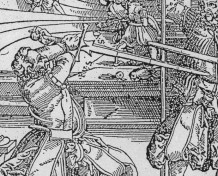 A Federschwert ("Feather swords") is a foiled practice
blade with a large flanged ricasso and a thick but narrow blade used
for longsword training. We can find examples of these swords in the
old Martial Arts Fechtbucher (fight books) from the early 1420s
up until the early 17th century, but they might have been in use for
a longer period of time. We see many varying styles of Feders
as their designs change from Fechtbuch to Fechtbuch.
The style of Feder in the Landesmuseum is one that I've been
unable to find in the Fechtbucher, but Joachim Meyer's Fechtbuch,
Kunst des Fechten (circa. 1570), depicts specimens that are
similar. A Federschwert ("Feather swords") is a foiled practice
blade with a large flanged ricasso and a thick but narrow blade used
for longsword training. We can find examples of these swords in the
old Martial Arts Fechtbucher (fight books) from the early 1420s
up until the early 17th century, but they might have been in use for
a longer period of time. We see many varying styles of Feders
as their designs change from Fechtbuch to Fechtbuch.
The style of Feder in the Landesmuseum is one that I've been
unable to find in the Fechtbucher, but Joachim Meyer's Fechtbuch,
Kunst des Fechten (circa. 1570), depicts specimens that are
similar.
In Meyer's Kunst des Fechten, the corners of the flared ricasso
are slanted upward, away from the cross, and the ones on this piece
actually slope slightly downwards, which is a feature not uncommon
on 16th century two-handed greatswords. The age of this sword, though,
is almost one hundred years older; used around the time the anonymous
Fechtbuch, Codex Guelf was written; circa late-15th
century. The Feders found in this Fechtbuch are also
similar.
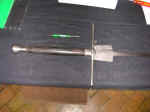 This Feder, despite it being about four and a half centuries
old, it is in excellent condition. The fourteen-inch long hilt still
has its original wood and stitched leather grip (though the leather
is naturally deteriorating), and is tight as a drum. The tang has
been hot peened through a simple Oakeshott Type T5 (pear shaped) pommel.
The pommel is medium sized, having a diameter of 1.75 inches. This Feder, despite it being about four and a half centuries
old, it is in excellent condition. The fourteen-inch long hilt still
has its original wood and stitched leather grip (though the leather
is naturally deteriorating), and is tight as a drum. The tang has
been hot peened through a simple Oakeshott Type T5 (pear shaped) pommel.
The pommel is medium sized, having a diameter of 1.75 inches.
The eleven-inch cross is also very simple. It is only a round steel
bar with a 0.4 inch diameter, which is swelled enough in the middle
to accommodate the blade. It does have a lump of an ecusson to accommodate
the thumb for various gripping positions. The grip is a plain, slightly
swollen, flattened oval with the dimensions of 1.49 by 1.35 inches
at its widest point.
The 37.5-inch long blade is basically a flat rectangular tempered
steel bar. In my haste, I neglected to measure the dimensions of its
narrowest point so you will have to estimate from the picture.
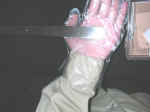 When measured out to seventeen inches from the cross, the blade is
0.38 inches thick by 0.8 inches wide, thinning out to be 0.1 inches
thick by 1 inch wide at thirty-six inches from the cross. At 27.4
inches from the cross is where most of the distal tapering occurs,
and it gets considerably whippier, taking only a little pressure to
bend it off line. This reflects the ideal striking portion and such
flex at this location is something not uncommon even on sharp fighting
swords. Although the blade sags slightly under its own weight, it isn't, in
my experience, to an extraordinary degree. This is not unusual in
some longer swords with a thin diamond or oval cross-section. When measured out to seventeen inches from the cross, the blade is
0.38 inches thick by 0.8 inches wide, thinning out to be 0.1 inches
thick by 1 inch wide at thirty-six inches from the cross. At 27.4
inches from the cross is where most of the distal tapering occurs,
and it gets considerably whippier, taking only a little pressure to
bend it off line. This reflects the ideal striking portion and such
flex at this location is something not uncommon even on sharp fighting
swords. Although the blade sags slightly under its own weight, it isn't, in
my experience, to an extraordinary degree. This is not unusual in
some longer swords with a thin diamond or oval cross-section.
The large ricasso is three inches long by 2.85 inches wide and is
0.21 inches thick. It has a strange cross section due the fact that
it has two odd, slightly angled fullers, one on each opposite side.
They are wider at the top of the ricasso, and grow thinner as they
angle towards the center of the cross, finally disappearing about
one inch from it. This sword weighs a little over three pounds, and
with the balance point being only 1 inch from the cross, makes this
a quick and agile sword.
Basic Information:
Code # KZ1030
Total Length - 51.5 inches
POB - 1 inch from cross
COP - 22.5 inches from cross
Weight - 3.12lbs (1.415kg)
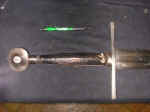 This next sword is type XIIIa of the Oakeshott classification. A
sword we would call a great sword, or sword of war. It becomes obvious
why very quickly. Some of these swords are what we call true two-hand
swords, because they are too hefty to manage with just one. On average,
these have a blade between thirty-two, to forty inches long with a
six to ten inch grip. The edges of these swords run nearly parallel
until tapering to a round point. Obviously lacking in the thrusting
category, they are powerful cutters. This next sword is type XIIIa of the Oakeshott classification. A
sword we would call a great sword, or sword of war. It becomes obvious
why very quickly. Some of these swords are what we call true two-hand
swords, because they are too hefty to manage with just one. On average,
these have a blade between thirty-two, to forty inches long with a
six to ten inch grip. The edges of these swords run nearly parallel
until tapering to a round point. Obviously lacking in the thrusting
category, they are powerful cutters.
This specific sword is roughly around the same age as the earlier
Feder, dated to about the early 15th to mid-16th century. It
still has its original wooden grip, but it is splintering badly, making
the tang visible on one side. The hilt is twelve inches long with
a large squared type "J" pommel and an eight-inch long type
2 cross.
The thirty-six inch long blade is in excellent condition for its
age, and even retains its chisel-like edge (although the very tip
has chipped off). A wide shallow fuller runs exactly half way down
the blade.
 The dimensions of the ricasso are 2.18 inches wide by 0.28 inches
thick. This tapers down only slightly to being 1.75 inches wide by
0.2 inches thick seventeen inches down the blade. At thirty-four inches
down, it is a bit narrower at 1.35 inches, but it hasn't changed much
in thickness at 0.18 inches thick. The dimensions of the ricasso are 2.18 inches wide by 0.28 inches
thick. This tapers down only slightly to being 1.75 inches wide by
0.2 inches thick seventeen inches down the blade. At thirty-four inches
down, it is a bit narrower at 1.35 inches, but it hasn't changed much
in thickness at 0.18 inches thick.
Although this sword doesn't have too much of an apparent distal taper,
the large pommel balances the sword nicely. I wouldn't necessarily
consider this a true two-hander, but I wouldn't be too comfortable
wielding it with only one.
Basic Information:
Code # Der498
Total Length - 48 inches
POB - 3 inches from cross
Weight - 4.63lbs (2.10kg)
The next longsword examined is classified as being a type XVII, and
is very similar to ones found on page 160 to 162 of Oakeshott's Records
of the Medieval Sword.
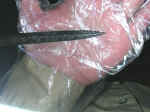 This type of sword is an armor fighting type. Due to the advances
in armor, cutting swords were being supplemented with stiffer tapering
swords that excelled in thrusting. Such swords needed to be able to
thrust through the links in mail and the gaps in plate armor. This type of sword is an armor fighting type. Due to the advances
in armor, cutting swords were being supplemented with stiffer tapering
swords that excelled in thrusting. Such swords needed to be able to
thrust through the links in mail and the gaps in plate armor.
XVII are always hand-and-a-half swords with a rigid stiff hexagonal
blade, sometimes with a shallow fuller. A round flat pommel is found
on about 75% of all surviving swords of this type, and the same in
monumental brasses and sculptures.
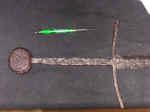 This sword is very much your average XVII. Discovered in a Swiss
lake, this fourteenth century longsword is in "excavated"
condition, so keep that in mind when studying my measurements. Although
the grip has long since rotted away, the 9.2-inch hilt is solid and
secure (though this may be due to corrosion). The pommel is a type
H1 which first appears around 1350 but fell out of favor by the first
quarter of the fifteenth century. The cross is a basic down turned
type 7 and is eight inches overall. This sword is very much your average XVII. Discovered in a Swiss
lake, this fourteenth century longsword is in "excavated"
condition, so keep that in mind when studying my measurements. Although
the grip has long since rotted away, the 9.2-inch hilt is solid and
secure (though this may be due to corrosion). The pommel is a type
H1 which first appears around 1350 but fell out of favor by the first
quarter of the fifteenth century. The cross is a basic down turned
type 7 and is eight inches overall.
The blade is 37.5 inches long and has somewhat of an edge for the
first few inches down the blade. The tip of this sword is frighteningly
acute. The ricasso is 1.34 inches wide by 0.4 inches thick and tapers
down to 0.85 inches wide by 0.38 inches thick at twenty-one inches
from the cross. As you get close to the point, the hexagonal blade
changes into a thick diamond cross-section. The dimensions at thirty-six
inches from the cross are 0.4 inches wide by 0.17 inches thick.
Basic information:
Code # LM70574
Total Length - 46.7 inches
Weight - 3.018lbs (1.369kg)
 This
last sword is from the early 17th century and is hard to classify.
Although it has a straight blade like a cut-and-thrust sword, the
"point" is as round as the Feder's, and it handles
more like a falchion. It has a This
last sword is from the early 17th century and is hard to classify.
Although it has a straight blade like a cut-and-thrust sword, the
"point" is as round as the Feder's, and it handles
more like a falchion. It has a 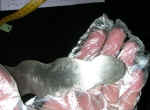 beautiful wire wrapped hilt, and magnificent fluted hollow-ground
spiral pattern on the quillons, and on the side, finger, and thumb
rings. The sword is in excellent condition, the hilt is sturdy, and
the blade still has a good edge. Although small, this sword feels
substantial, and would be an excellent cutter. Such "flammarde"
styles were also known on two-handers as well as rapiers and cut-and-thrust
swords.
beautiful wire wrapped hilt, and magnificent fluted hollow-ground
spiral pattern on the quillons, and on the side, finger, and thumb
rings. The sword is in excellent condition, the hilt is sturdy, and
the blade still has a good edge. Although small, this sword feels
substantial, and would be an excellent cutter. Such "flammarde"
styles were also known on two-handers as well as rapiers and cut-and-thrust
swords.
Basic Information:
Code # DEP499
Total Length - 38 inches
POB - 4 inches from cross
Weight - 3.28lbs (1.495kg)
Sources:
The Archeology of Weapons, R. Ewart Oakeshott
Records of the Medieval Sword, R. Ewart Oakeshott
|

